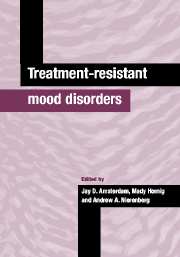Book contents
- Frontmatter
- Contents
- List of contributors
- Preface
- Part I The clinical problem
- Part II Biological basis
- 3 Psychoneuroendocrine aspects of treatment-resistant mood disorders
- 4 Estrogen and depressive illness in women
- 5 Sleep abnormalities in treatment-resistant mood disorders
- 6 Structural and functional brain imaging in treatment-resistant depression
- 7 Immunologic factors in treatment-resistant depression
- Part III Treatment approaches
- Part IV Special patient populations
- Part V Economic and ethical issues
- Index
- Plate Section
6 - Structural and functional brain imaging in treatment-resistant depression
from Part II - Biological basis
Published online by Cambridge University Press: 25 March 2010
- Frontmatter
- Contents
- List of contributors
- Preface
- Part I The clinical problem
- Part II Biological basis
- 3 Psychoneuroendocrine aspects of treatment-resistant mood disorders
- 4 Estrogen and depressive illness in women
- 5 Sleep abnormalities in treatment-resistant mood disorders
- 6 Structural and functional brain imaging in treatment-resistant depression
- 7 Immunologic factors in treatment-resistant depression
- Part III Treatment approaches
- Part IV Special patient populations
- Part V Economic and ethical issues
- Index
- Plate Section
Summary
Introduction
Mood disorders are a heterogeneous group of illnesses which vary in clinical features such as symptoms, severity, and longitudinal course. Emerging research suggests that clinical diversity reflects biologic heterogeneity, and this notion is supported by the fact that the effectiveness of treatments can vary markedly across patients. Methods to more effectively target therapeutics in treatment-resistant mood disorder patients are sorely needed. In this chapter we consider the insights that structural and functional brain imaging methods have offered into the neural substrates of affective processes as well as the current and possible future utility of these methods in the evaluation and management of patients with treatmentresistant mood disorders.
The neuroanatomy of affective processes
Neuroanatomic models
Neuroanatomic models of the substrates of affective processes were originally derived from non-human animal studies in addition to postmortem and in vivo studies of humans with brain trauma, neurologic, and psychiatric disorders. More recently, brain imaging studies of healthy volunteers and mood disorder patients have helped refine models of healthy and pathologic affective processes.
Midline cerebral structures have long been considered possible mediators of affective experiences. Over a century ago, Broca defined the great limbic lobe as a midline cortical limbus (border or ring) around the brainstem in mammals (Broca, 1878). In 1937 Papez proposed a corticothalamic mechanism of emotion in which the hypothalamus was the origin of emotional impulses, that were sent to mamillary body, thence to anterior thalamus, and then on to cingulate, which through cortical projections could add affective valence to various cerebral processes (Papez, 1937).
Keywords
- Type
- Chapter
- Information
- Treatment-Resistant Mood Disorders , pp. 111 - 141Publisher: Cambridge University PressPrint publication year: 2001



